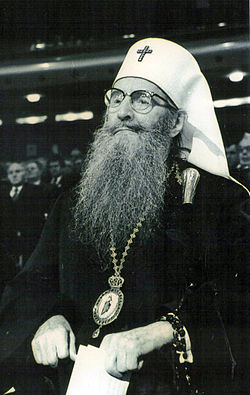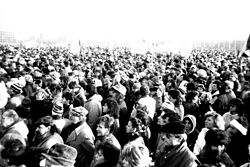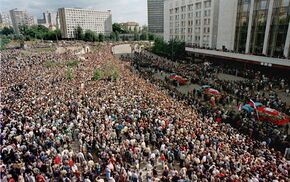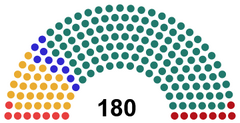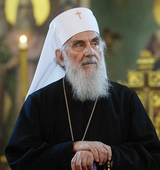Radushia
Sotirian Republic of Radushia Сацірскі Радауская Чува́шская Sacirski Radauskaja Respublika | |
|---|---|
Motto:
| |
Anthem:
| |
| Capital and largest city | Chrivotava |
| Official languages | Belonarodyn |
| Recognised national languages | Narodyn |
| Religion | Episemalist Sotirianity 90.2% Irreligious 6.4% Other 3.4% |
| Demonym(s) | Radushian |
| Government | Unitary dominant party theocratic parliamentary republic |
| Macarius II | |
| Ramon Yarmoshyn | |
| Roman Sivak | |
| Legislature | Viarchoŭny Rada |
| Independence from Narozalica | |
• Declaration of Independence | 14 November 1979 |
• Treaty of Boltovo | 3 April 1980 |
• Saint George's Day Revolution | 6 May 1982 |
• Sotirian Republic established | 1 June 1982 |
• Current constitution | 6 May 1999 |
| Area | |
• | 8,646 km2 (3,338 sq mi) |
• Water (%) | 3.5% |
| Population | |
• 2020 estimate | |
• 2016 census | 4,102,147 |
• Density | 485.04/km2 (1,256.2/sq mi) |
| GDP (PPP) | 2019 estimate |
• Total | |
• Per capita | |
| GDP (nominal) | 2019 estimate |
• Total | $41.92 billion (36th) |
• Per capita | |
| Gini | 29.9 low |
| HDI | high |
| Currency | Radushian Zolota (RUZ) |
| Driving side | right |
| Internet TLD | .rd |
Radushia (Чува́шская; Radushiya), officially the Sotirian Republic of Radushia (Сацірскі Радауская Чува́уская; Sacirski Respublika Radushiya) is a landlocked country located in western Euclea, bordering Poliania to the west, Narozalica to the north, XX to the east and Lake XXX to the south. A small nation, it has a total area of 4,646 km² (3,338 sq mi) and a population of 4.91 million. It's capital is Detkovo and its largest city is Boltovo.
History...
History...
Today, Radushia is a member of the Community of Nations, ITO and the GIFA. Radushia is also a member of Samorspi. Despite it's size, Radushia holds significant cultural and religious influence, especially among nations of the Epistmalist Catholic Church. Radushia's economic growth and development has improved in recent years, with continued rise in living standards and incomes.
History
Pre-history
Ancient
Principality of Radushia (1085-1466)
Kingdom of Radushia (1466-1721)
Narozalic Empire (1721-1861)
Narozalic Republic (1861-1979)
Independence
Tensions in Narozalica over the growing authoritarianism of President Vilem Gardos emerged as early as 1971, where he set about centralising executive power in his hands. In 1973, Radushia's state governor, Sergei Golovchenko was forced to resign by the ruling Radushian branch of the Narozalic Nationalist Party, he was succeeded by the relatively unknown Alexander Nivitsky, who shared close ties to the Gardos regime in Samistopol. Prior to his appointment as Golovchenko's successor, Nivitsky had worked in various positions in the NNP and was a fervent supporter of Gardos and his plans for a powerful centralised Narozalic state. Between 1973 and 1979, Nivitsky's agenda as governor was seen as lacklustre and was regularly accused of pandering to the interests of Gardos over those of Radushia by the former's critics both in Samistopol and within Radushia. In 1976, Nivitsky was re-elected as Governor of Radushia in a state election widely condemned as fraudulent, however, the support of Gardos himself protected Nivitsky from any significant protest and he was formally re-appointed.
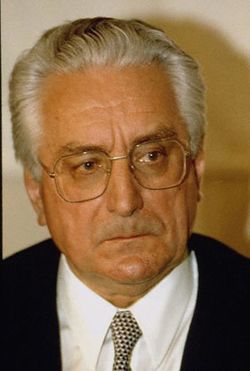
However, as opposition to Gardos began to grow in scope and intensity by the late 1970s, Nivitsky began to noticeably withdraw from the President. In 1978, he withheld the police and paramilitary units from confronting a mass nationalist rally held in Chrivotava in August of that year. The following month, Radushian nationalists, who saw the Gardos regime as inconsiderate of Radushian interests, coupled with a rising desire for democracy and civil liberties, established the Radushian Freedom and Justice Party to compete against Nivitsky and the NNP at the election set for 1980. A groundswell in support for the RFJP led to Nivitsky withdrawing his membership of the NNP and declared his moral support for the RFJP and pledged to run for governor as an independent. This led to a cascade of NNP figures and politicians abandoning the party and declaring support for the Freedom and Justice Party either morally or through outright defection.
The Tokar mutiny at the Sostava military base on August 21 1979, sparked the devastating Sostava War, that would ultimately overthrow Gardos and his regime. Almost immediately in wake of the mutiny, Nivitsky withheld Radushian provincial forces from being deployed by order of the Gardos government in Samistopol. The rapid spread of mutinies at military bases across eastern Narozalica eventually reached Radushia in late November, with heavy fighting erupting between the two sides at the Ozernitsa Army-Air Base. Fearing Radushia becoming a battlefield, Nivitsky ordered the deployment of provincial forces around the base to contain the fighting. The same month saw Nivitsky be repeatedly warned by allies that unless he made moves toward independence, he risked being overthrown by ever growing support for the RFJP.
On December 18, Nivitsky informed Radushians by radio, that he had secured the backing of the provincial legislature and the RFJP in issuing a unilateral declaration of independence. Utilising the victory of the Partisan forces at Ozernitsa, Nivitsky entered negotiations with the ascendant rebels, securing recognition of Radushian independence from Sava Tokar in exchange for materiel support and limited numbers of Radushian volunteers. The Nivitsky government and Tokar’s movement signed the Treaty of Boltovo in late August 1980, which confirmed Radushian independence, though it would not be officially recognised until international law until 1982, when Sava Tokar succeeded the deposed Gardos as the internationally recognised leader of Narozalica.
Political crisis (1980-82)
In wake of the declaration of independence on December 18 1979, Nivitsky announced the creation of a provisional government headed by himself as Interim President. The UDI had the unforeseen consequence of prompting a swift collapse of the Radushian Freedom and Justice Party, which was comprised of numerous right-wing, liberal and left-wing parties and whose unity was dependent solely on the securing of independence. The issue at hand following Nivitsky’s UDI was now the formation of a political system and these groups sought conflicting results.
Four parties emerged out of the collapse of the RFJP, the left-wing All-Radushian Democratic Socialist Union, the liberal, New Democracy Movement, the right-wing Party of Patriots and the All-Radushian Sotirian Party. The Democratic Socialist Union was aided by the swift endorsement of all Radushia’s trade unions and a historic left-wing underground movement. The DSU also boasted links to the stilling fighting New Voyins Movement in Narozalica, these advantages provided the DSU the means to organise and develop its support base at a quicker pace than its opposition. Alexander Nivitsky’s lack of support among the right-wing, who saw him as a stooge of Gardos, even after the latter’s downfall denied Nivitsky a new platform. The liberals equally mistrusted Nivitsky’s intentions and refused to grant him their support as interim president. However, Nivitsky’s approaching of the DSU proved successful, in exchange for them supporting him as interim president, he would support their agenda. Nivitsky would claim in interviews in following days, that he had been a life-long socialist, but hid his true beliefs owing to Narozalica’s politics leading up to the Sostava War.
On September 3, Nivistky announced fresh elections to appoint members to a new unicameral assembly. This was criticised by the other parties, as no other group had been consulted on an unicameral system being adopted, nor had any other group been given chance to debate its merits. Nivitsky worked to ensure the continued presence of NNP appointed electoral officials within the newly formed Provisional Elections Commission, aided by the provisional government being formed out of the former NNP-dominated state administration. On October 3, the first election held since independence resulted in a landslide for the DSU, in what was immediately condemned as fraudulent by the Party of Patriots due to widespread reports of ballot stuffing and the falsifying of results, however, the chaotic nature of the vote denied any confirmation of these accusations.
On October 5, Nivitsky ordered the establishment of a Constitutional Development Committee. He ordered that the CDC be representative of the distribution of seats in the Provisional Assembly, giving the DSU an overwhelming majority in the 32-seat group. The Party of Patriots refused to recognise the body and withheld its members. The PP’s seats were distributed between the DSU and the main opposition party, the All-Radushian Sotirian Party. The CDC under the control of the DSU began to produce constitutional proposals markedly left-wing, with each point only needing a majority vote, the opposition became powerless. On October 29, the ARSP withdrew from the CDC, condemning it was a vehicle for a “left wing takeover of Radushia”, sparking mass protests and a political crisis.
The mass protests were limited to Chrivotava for the remainder of 1981, with only the most vocal supporters of the PP and ARSP taking to the streets. The liberal, New Democracy Movement would remain in the CDC until January 1982, when the DSU voted through plans for an influential economic council, which would provide a deciding role for trade unions. On January 10, it was revealed that the DSU was seeking to secularise Radushia, formally removing the Episemalist Church of Radushia from all areas of life. This unleashed mass protests in every major city in the country, as well as rioting and violent clashes with DSU supporters and police in Chrivotava.
On February 11, armed supporters of the DSU opened fire on protesters in the southern city of Ostteta, killing 4 people. The incident served to shatter what little relationship existed between Nivitsky and the Episemalist Church and on February 12, Patriarch Michal IV denounced the provisional government and the DSU. On March 1, three Episemalist priests were kidnapped and murdered by extreme elements affiliated with the DSU, the murders further fuelled the mass protests that now involved the occupation of businesses, factories and public buildings. The unrest, concurrent to the collapse of trade with still war-torn Narozalica, sent the Radushian economy plummeting. The mass flight of Radushians for Eastern Euclea began in mid-March and would continue for over 10 years.
In April, 20 regional commanders of the Radushian Police Force resigned their positions in protest of being ordered to overlook violence committed by the DSU and its supporters. The resignations escalated into mass defections of police officers to the protesters, while Alexander Nivitsky’s call for military intervention went unanswered on April 24. Six days later, Patriarch Michal IV called upon all “Godly and decent Radushians to take to boldness and march in unison against the left-wing threat.” Across Radushia, priests and bishops joined the protesters, and rumours began to circulate of a possible coup against Nivitsky and the DSU. Between April 25 and May 5, over a million Radushians took to the streets in protest, calling for fresh elections and the removal of Alexander Nivitsky.
Saint George's Day Revolution and establishment of the Sotirian Republic
In response to the Patriarch’s second intervention, Nivitsky began to amass many supporters around the Governor’s Mansion in Chrivotava, including a number of armed DSU members. Coalescing around him were numerous wealthy Narozalican elites, who previously held prominent positions in the provisional government, bringing with them armed bodyguards contracted from organised criminal groups. These individuals would stage running battles with protesters, while gunshots were regularly heard in the city centre as the mass movement against Nivitsky and the DSU reached its height.
On May 5, 4,500 soldiers of the Provisional Radushian Army entered the capital late at night and took up positions both in the city centre and the outskirts, blocking key entry points. In the morning of May 6, the PRA attempted to storm the Governor’s Mansion but suffered losses to DSU gunmen. Gunfire and explosions were soon being reported across central Chrivotava as Nivistky and DSU loyalists opened fire on the troops and protesters alike. However, the deployment of tanks by the Provisional Army by late afternoon, coupled with the successful clearing of buildings and soldiers forced the flight of Alexander Nivitsky and his wife and two adult children by helicopter to their compound on the shores of Lake Min, while the DSU holdouts were systematically killed or captured.

At 20.35pm, Patriarch Michal, alongside his most senior bishops and the commanders of the Provisional Armed Forces appeared on live television to announce the overthrow of the provisional government. The Patriarch also claimed that the military had invited him to lead a “provisional authority dedicated to the correct construction of a new Radushia.” Nivitsky and his family fled to Tengaria by their luxury yacht at midnight. He would be extradited in 1985 and was sentenced to death for crimes against humanity.

Overnight, the Provisional Army backed by armed protesters pursued, killed or captured known DSU members, while many others including its de-facto leader, Pavel Domrachev fled to Narozalica to serve with the New Voyins Movement. The following morning, Patriarch Michal addressed the Provisional Assembly minus the DSU cohort, informing them that he would “oversee and mediate, not direct or manage” the formulation of a new constitution or political system. His first order as the Interim Leader was restore order to Radushia’s streets, demanding people return to their homes and workplaces. Over the course of the political crisis from late 1980 until the Saint George’s Day Revolution on May 6 1982, over 1,200 people had been killed, with over 300 killed in the final days of April and the beginning of May. A further 2,300 people would go missing or officially executed by the new provisional government for defending the Nivitsky-led government.
The Second Provisional Government under Patriarch Michal IV spent much of its early existence lauding its role in the overthrow of Nivitsky, and despite early assurances, failed to remove the thousands of soldiers from the streets of Chrivotava. Utilising the pulpit, the Episemalist Church began to argue that only it could provide the necessary unity and reliability to prevent the rise of another strongman or aspirational dictator. The subsequent fresh elections in late September delivered a strong majority for the All-Radushian Sotirian Party, that was tactily endorsed by the Church and military. The ARSP secured Ana Knorina as Interim Prime Minister and she soon won concessions from the opposition in introducing a powerful executive position for whoever serves as the Patriarch of the Radushian Episemalist Church. Supported by widespread goodwill and adoration, the proposal was well-met and this was followed by further powers for the Patriarch and the Episemalist Church, including its role in appointing the Chiefs of the General Defence Staff, law enforcement and security services. The constitutional also saw the declaration of Episemalism as the state religion and the imposition of complete bans on abortion and contraception, while guaranteed rights to freedom of speech, press, assembly and others were introduced.
By early October, the constitution was complete and was put to referendum vote on October 18 1982. Controversially, the question put to the people was "Do you want a Sotirian Republic?" rather than the originally agreed "Do you support the proposed constitution of Republic of Radushia?" Not only was the question misleading, but soldiers were present at every polling station for reasons of "state security" and in the weeks leading up to the referendum, Episemalist priests used Sunday Mass to advocate for the constitution. The new constitution was backed by 88% to 12% against, and the Sotirian Republic of Radushia was formally established on October 19.
Modern (1982-present)
The establishment of the Sotirian Republic in October 1982 did little to deter the mass exodus of Radushians for East Euclea. The country’s economy was still in crisis and the Radushian talon was plummeting in value. On November 23, Minister-President Ana Knorina was sacked by Supreme Patriarch Michal IV for failing to confront the economic crisis and was replaced by Dmitry Markov, who instituted price controls on certain goods and announced the phased replacement of the talon with the Radushian zolota. From independence in 1980, Radushia had lost 45% of its GDP and inflation had reached 586% as of Markov’s appointment. The number living under the poverty line had increased from 24% to 57% and unemployment was averaging 18%.
The removal of the far-left from Radushian government and politics had been successful in enticing investment from Eastern Euclea, while strict austerity and the reorganisation of former provincial-owned companies followed. In late 1982 and early 1983, a select group of Radushian businesspeople were given approval to purchase Narozalican state-owned enterprises located in Radushia. These entities were sold at below market prices owing to the civil war, and while these enterprises were occasionally stripped mined for assets, others were reorganised into profitable businesses. This process served to stem the tide of unemployment, but also established a class of oligarchs inherently tied to the Radushian state.
In 1986, the Radushian zolota was officially introduced and later that year, the country recorded positive GDP growth for the first time in six years. That year, the ARSP and Dimtry Markov were re-elected to government. Over the next four years, the ARSP began to implement a series of reforms that boosted the power of the Episemalist Church and centralised power in the hands of the Minister-President. Among those measures was the establishment of the Integrity Division, a law enforcement body tasked with combatting vice and promoting civic morality and answerable only to the Supreme Patriarch. This was followed in 1988, with the introduction of new laws effectively censoring the printed and televised media, originally aimed at combatting profanities and intimate scenes, it evolved into the censoring of criticism of the Church and the Supreme Patriarch.
In 1989, Patriarch Michal IV died and was succeeded by Andrey. Patriarch Andrey had played a significant role during the 1982 revolution, organising the use of the Church to advocate the overthrow of Nivitsky and the establishment of the Sotirian Republic. Andrey played a more active and public role in comparison to Michal and would spearhead many of the initiatives aimed at promoting natalism, public morality and the repression of criticism. In 1990, the ARSP was re-elected under Symon Malofeyev, the results were disputed by several opposition parties owing to the poor poll ratings of the ARSP, sparking the 1990 Radushian protests. Over the course of five weeks, mass protests were met by riot police and draconian measures. The protests were ultimately crushed, leaving 14 people dead and thousands arrested, however, Patriarch Andrey would go on to sack Malofeyev and appointed the more popular Piotr Dyagilev, who calmed the national mood, while securing the ARSP’s re-election.

During the 1990s, Radushia’s population decline was steadied, and its economic growth averaged 7%. The poverty rate fell and premature deaths by curable diseases and alcoholism also fell to their lowest levels since independence. The Dyagilev government instituted economic and social reforms aimed at promoting entrepreneurialism and diversification of the economy away from agriculture and gas exports. In 1994, the government banned gambling in all its forms across the country, including the popular National Lottery. The ARSP would be re-elected again in 1995, though with a reduced majority. In 1996, over 670 miners were killed in the Marokharava disaster, which brought to public attention the poor degree of health and safety regulations and the poor treatment of manual labourers by the oligarchic class which dominated Radushian mining. Mass protests and strikes secured reform from government, though no action was taken against the mistreatment of workers. In 1998, a series of constitutional amendments were adopted, which specifically introduced new qualifications for public office. The new qualifications would serve to attack prominent or capable opposition leaders by banning them from public office, and the ARSP would also be served with a new electoral system designed to benefit them through gerrymandering.
In 2000, Patriarch Andrey died and was succeeded by Patriarch Liavoncij II who sought to soften and liberalise the Sotirian Republic. Among his reforms enacted by the ARSP government under Minister-President Dyagilev, included the loosening of the censorship system for television and music, easing the means of securing a divorce and reducing the Church’s own role in political affairs. In 2001, Liavoncij II prohibited the Episemalist clergy from lobbying politicians or heading political interest groups. In 2003, the Radushian population recorded its first year of positive natural growth, while the number of expatriates returning home had increased to 13% annually from 6%. Radushia’s economy would continue to grow at one of the fastest rates in Euclea during this time, with the country avoiding recession during the 2005 Economic Crisis.
In 2015, Patriarch Liavoncij II was succeeded by the current Supreme Patriarch, Macarius II.
Geography
Radushia is a landlocked country located in Western Euclea. It is bordered to the north by Narozalica, Vedmed to the east, Lake Min to the south and XX to the west. The country has a total area of 8,646 km2 (3,338 sq mi), making it one of the smallest countries in Euclea and the world. Radushia's geography is defined by the Dolomit River, which disects the country in half from north-to-south, where it deposits into Lake Min. The entire country also resets within the Dolomit's drainage basin. Surrounding the delta of Lake Min is the Ščodraja Raŭnina (Щчодрасці Pаўніна; lit. the Generous Plain), an area of rich fertile soil and dominated by flat plains and farmland. The Ščodraja Raŭnina covers the entirety of Radushia's shoreline with Lake Min and runs northward toward the Navahrudak foothills, which ultimately settle into the Radushian plateau. To the west of Radushia is the XX Mountains, which raise the elevation of the country's most westward regions. Northern Radushia besides the Dolomit River valley is dominated by forested regions and rolling hills. Historically, Radushia was covered by forest to a degree of 75%, yet human development and industrialisation has since reduced this number to 30% of total land area.
Radushia hosts 8 national parks, 35 landscape protection area and 77 minor nature reserves. Since 1990, the numbers of such areas has declined, with the Slonim-Mihai National Park having been closed down in 2009 and de-registered to enable economic development.
Climate
Due to Radushia's geographical position in central western Euclea and its distance from open sea, the country has a climate that is continental and temperate, with the four seasons taking distinct forms. The annual temperature on average is 13 °C (55 °F) in the south around Lake Min and 9 °C (48 °F) in the north. During summer, average temperatures at their height in Chrivotava rise to 29 °C (84 °F), and temperatures surpassing 35 °C (95 °F) are common in low-lying areas of the country, especially those of the Ščodraja Raŭnina. The coast of Lake Min during summer sees the most limited range in temperature changes and enjoys limited humidity, providing it a comfortable warm summer each year. During winter, the average temperature is below 3 °C (37 °F), with minimum temperatures of -1 °C (30 °F) being recorded in low-lying areas. Precipitation is average, with over 780 mm (30.7 in) per year in the north and west, around the Navahrudak foothills, while around Chrivotava it drops to approximately 670 mm (26 in).
Fauna and flora
Radushia is divided into two distinct zoological and biodiverse regions, one being the Navahrudak-North and the Lake Min-South. The north is dominated by species common to mixed forests and higher elevations, while the south is dominated by species native to riverine marshland and open plains. In the north, species such as lynxes, wolves, martens and wild boar are very common and vibrant. In the far-west of the country, populations of brown bears are still reported, though their numbers have dwindled in recent years. In the south, along the Dolomit River and the shores of Lake Min, species such as river beavers, otters and mink are not uncommon. Both Lake Min and the Dolomit River are host to large populations of storks. Radushia's bird populations also include game birds, raptors, song birds, nighthawks, waterfowl, swifts, and waders.

Government and politics
 |
|
Government (126) All-Radushian Sotirian Party (126) Opposition (54) Civic National Party (28) Sotirian Party of the Regions (10) Workers' Dignity (8) Party of the Radushian Motherland (8) |
The government and political system of Radushia is defined by the 1982 constitution adopted in wake of the Saint George's Day Revolution. Officially, Radushia is a unitary parliamentary republic with a fusion of theocratic elements and is a multi-party democracy. However, in reality, many observers consider Radushia to be a hybrid regime under a dominant party supported by an authoritarian theocratic framework.
The head of state of Radushia is the Supreme Patriarch, who holds the office for life and concurrently to serving as the Patriarch of the Radushian Episemalist Church and Metropolitan of Chrivotava. The office of the Supreme Patriarch is embued with several executive perogatives and powers, including the right to appoint and dismiss Minister-Presidents, any cabinet minister or the government in entirety, dissolving the Viarchoŭny Rada and appointing and dismissing the heads of the armed forces, security services and state broadcasters. The Supreme Patriarch's spiritual influence also plays a significant role in temporal matters and can alter the fortunes of both government and legislation alone. The current Supreme Patriarch is Macarius II, who was elevated to the Patriarchate in 2014.
The position of Minister-President, Radushia's head of government, belongs to the individual most likely to command the confidence of the Viarchoŭny Rada; this individual is typically the leader of the political party or coalition that possesses the largest number of seats. By convention, the Supreme Patriarch would appoint that person to serve as head of government, however, the Supreme Patriarch is entitled to appoint anyone he believes would serve the interests of the nation. On three occassions, the Supreme Patriarch has selected another beside the party or coalition leader. The Minister-President chairs the Council of Ministers, whose appointment is dependent upon the confidence of the Supreme Patriarch. The current Minister-President is Ramon Yarmoshyn who has served since 2014.
The legislature of Radushia is the unicameral Viarchoŭny Rada, comprising of 180 seats. All members of the government, including the Minister-President must be a serving member of parliament in order to serve, as a result, the Radushian government is accountable to the Rada. For elections to the Viarchoŭny Rada, its 180 representatives are elected by parallel voting, with 90 seats elected by first-past-the-post and 90 elected through proportional representation, with a national threshold of 6%. Officially, elections are held every give years, however, the Supreme Patriarch is entitled to dissolve the Viarchoŭny Rada at his pleasure, he may also dissolve the Rada at the request of the Minister-President. Since the Saint George's Day Revolution in 1982, the All-Radushian Sotirian Party has been the dominant party having serve in government uninterrupted since. Besides the All-Radushian Sotirian Party, there is the Civic National Party, Party of the Radushian Motherland, Workers' Dignity and the Sotirian Party of the Regions.
Supreme Patriarch
The Supreme Patriarch of the Republic is responsible for supervision of government and providing stability and national unity as the figurehead. The role of the Supreme Patriarch has been compared to a semi-constitutional monarch, rather than the final authority in Radushian politics. Beyond the Patriarch’s right to appoint and dismiss either individual ministers or entire governments, there is limited capacity for the Supreme Patriarch to dictate or introduce policy himself. However, owing to the influence the Supreme Patriarch exudes owing to his spiritual office, it has been noted that a politically active Supreme Patriarch could influence government policy through spiritual pronouncements or edicts. Furthermore, observers have noted under the current Supreme Patriarch, Macarius II, the Radushian government has repeatedly deferred to his opinion on social matters.
One area where the Supreme Patriarch’s influence diminishes the elected government is defence and national security, where the heads of the armed forces, law enforcement and the security services are appointed directly by the head of state. The country’s morality police, known as the Integrity Division (пяхотная дывізія; Celasnasć Dyvizija) is answerable only to the Supreme Patriarch and its budget is held secret from the Rada. As the Supreme Patriarch is also commander-in-chief and appoints the heads of the Radushian Defence Force, the incumbent is able to establish a support base within the military, while civilian oversight of the military is side-lined. However, successive Supreme Patriarchs have delegated their responsibility of heading the State Security Council to the governing Minister-President.
Another key area where the Supreme Patriarch exudes significant influence over daily life, is his duty to appoint the heads of the various state broadcasters and agencies. The heads of RATRA, the National Administration for Theatre and Music, National Administration for Printed and Digital Media and the chief editors of state-owned newspapers. Through these appointments, the Supreme Patriarch can dictate the theme and allowances of Radushia’s media and press.
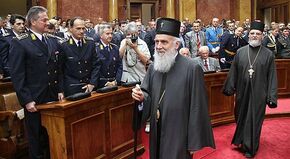
Under the 1998 Constitutional Amendments, the qualifications of candidates for political office were changed to include religious qualifiers. Among those included the immediate invalidation of a candidate if they were excommunicated from the Episemalist Church. Having engaged in extra-marital affairs, having undergone an early termination of a foetus and having criticised the Church in public or private. Since those qualifications were introduced, several leading opposition politicians have been barred from running for office owing to the Supreme Patriarch, in his spiritual capacity as Patriarch of the Church, approving the excommunication of candidates. Other cases have seen the Supreme Patriarch refusing to intercede when an excommunication order was signed by a local Priest and confirmed by the Bishop. This has enabled Supreme Patriarchs to use their spiritual office to affect elections in benefit of the long ruling All-Radushian Sotirian Party.
Role of the Radushian Epistmalist Church
Human rights
According to international NGOs and research groups, Radushia varies between the "Partly Free" and "Unfree" categories. Numerous institutions, including the International Council for Democracy and the Euclean Community have criticised the Radushian government for its attacks on media and press freedom, the persecution of critical journalists and reporters and activists. Censorship in Radushia remains strict for printed, televised and digital media, with both material and message subject to change prior to public release. Serious issues relating to arbitary arrest, state harrassment and allegations of torture have prevaded Radushia since the 1982 political crisis. The Integrity Division, Radushia's morality police has been known to target the LGTB community with excessive force, detention with charge and the forced disappearance of activists. Public assembly and protest has been subjected to harsh laws and restrictions, with limitations on the number of marchers or protesters and an order notice, mandating the arrest of any individual wearing a face covering at a protest, or carrying a bag or rucksack.
Electoral rights and electorial integrity has been widely condemned by the ICD and EC with numerous reports of ballot stuffing, voter intimidation and the use of state resources and institutions to benefit the ruling party. The 1998 constitutional amendments which introduced new qualifications entering electoral races has led to numerous state actions designed to invalidate highly capable candidates from opposition parties. The ICD has also criticised the use of the Episemalist Church by the state to influence elections, primarily the near constant endorsement of All-Radushian Sotirian Party candidates by local priests or bishops and the latter's use of the pulpit to condemn opposition parties.
Administrative divisions
According to the 1982 Constitution, Radushia is divided into four Provinces (Правінцыі; Pravincyi) and one Metropolitan Region (Cталічны Pэгіён; Staličny Vobłasć), covering the capital of Chrivotava. The provinces are further divided into Raions, the number being dependent upon the Province's population, while the Metropolitan Region is sub-divided into Quarters (Кварталы; Kvartaly). There are 100 Raions in Radushia as of 1998. Each Raion is governed by a Raion Authority (Raiona Ǔlada), which is democratically elected by its citizens every four years. The Raion Authorities are led by a Secretary-General, who is usually the leader of the largest party or coalition of parties in the Authority. The Secretary-General of each Raion is appointed by the Supreme Patriarch upon the result of each election. The powers delegated to the Raions is limited by the 1998 Constitution, as such, areas delegated proper including waste management, utilities, infrastructure maintenance and cultural affairs. The primary duty of the Raion Authorities according to the 1998 constitution, is the implentation of government policy.
The Metropolitan Region differs from the Raions, as each Quarter of the capital elects its own respective Metropolitan Council, while also directly electing members to the Metropolitan Authority, which governs the city as a whole. The Metropolitan Authority is led by a Mayor, and ejoys significantly more autonomy than the Raions.
The four provinces are as follows:
- Northern (Paŭnočny Pravincy)
- Western (Zachodniaja Pravincy)
- Southern (Paŭdniovy Pravincy)
- Eastern (Uschodniaja Pravincy)
- Metropolitan Region of Chrivotava (Staličnaja Voblasć Chryvatava)
Foreign relations
Armed Forces
The Armed Forces of the Sotirian Republic (Belonarodyn: Узброеныя Cілы Сацірскі Чува́шская; Uzbrojenyja siły Sacirski Respublika), colloquially known as USAR (Усар), is comprised of the Army of the Sotirian Republic, Radushian Air Force, Territorial Defence Force and the Maritime Flotilla of the Sotirian Republic, which is dedicated to patrolling the Radushian territorial waters in Lake Min and the Dolomit River. The Radushian armed forces are subordinate to the Ministry of Defence, the Chief of Staff is appointed by the Supreme Patriarch, who in turn chairs the Chiefs of the General Defence Staff.

Historically operating a considerably large system of conscription, in 2004, Radushia reformed to a mixed professional-conscription system, whereby the main branches of the armed forces, the Army, Air Force and Maritime Flotilla are volunteer based, while the auxiliary Territorial Defence Force employs 18,000 conscripts per year, who are required to serve for two years before being retained as reservists for a further three years. The Radushian military has 23,500 active personnel and 60,000 reservists as of 2019. The defence budget amounted to 2.1% of GDP in 2019.
In 2010, the Radushian government announced a major overhaul of the military's organisation and modernisation program of its equipment, training and operational theories. This includes new aircraft, helicopters, vehicles, weapons and increase use of unmanned aerial vehicles. Following independence in 1979, Radushia has maintained close economic, political and military ties with Narozalica, this includes regular joint training exercises, but also Radushia contributing the collective defence provided by Samorspi.
Law
Economy
Demographics
| Historical population | ||
|---|---|---|
| Year | Pop. | ±% |
| 1956 | 2,974,122 | — |
| 1966 | 3,535,140 | +18.9% |
| 1976 | 4,416,898 | +24.9% |
| 1986 | 4,400,024 | −0.4% |
| 1996 | 4,225,871 | −4.0% |
| 2006 | 4,008,715 | −5.1% |
| 2016 | 4,193,694 | +4.6% |
| Source: Narozalic Census (1956-1976) Radushian State Census (1986-) | ||
Ethnic groups
Language
Religion

Healthcare
Education

Education in Radushia is split roughly equally between state-run and church-run institutions. Church schools tend to be of higher quality in teaching, learning content and are widely seen as more prestigious than state-run institutions. However, criticisms exist in that Church-shcools operate beyond government oversight and have little accountability. Anti-government critics have argued that church schools in Radushia are designed to "entrench support for the theocratic system, over preparing students for careers."
Urbanisation
Chirvotava, the nation's capital and largest city, was home to 1,117,900 residents in 2018, representing 26.65% of the national population. Ottseda, with a population of 181,000, is the second-largest city and is located on the shores of Lake XXX. Other large cities are Svaryn (165,100), Sviaty Michal (118,400), Sviaty Mikola (89,800) and Aleksandrina (78,300).
Largest cities or towns in Radushia
NBS (2019) | |||||||||
|---|---|---|---|---|---|---|---|---|---|
| Rank | County | Pop. | |||||||
 Chrivotava  Ottseda |
1 | Chrivotava | Chrivotava | 1,117,900 |  Svaryn  Sviaty Michal | ||||
| 2 | Ottseda | Sviokrava | 181,024 | ||||||
| 3 | Svaryn | Kvatory | 165,137 | ||||||
| 4 | Sviaty Michal | Sviaty Michal | 118,444 | ||||||
| 5 | Sviaty Mikola | Sviaty Mikola | 89,800 | ||||||
| 6 | Aleksandrina | Vidamlya | 78,365 | ||||||
| 7 | Harbacha | Harbacha | 61,364 | ||||||
| 8 | Solomyn | Solomyn | 51,701 | ||||||
| 9 | Novaya Antonovka | Sviaty Paviel | 50,988 | ||||||
| 10 | Staraya Vodva | Sviaty Džordž | 47,532 | ||||||


